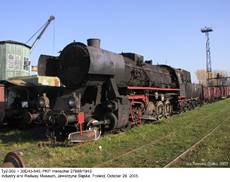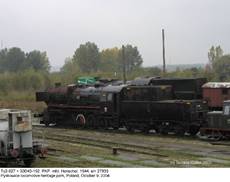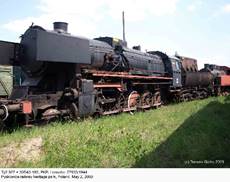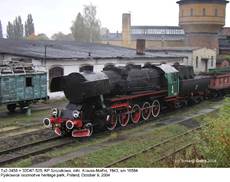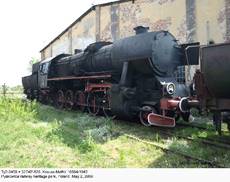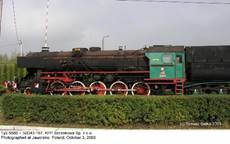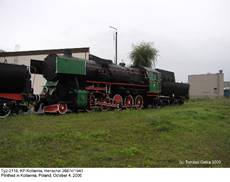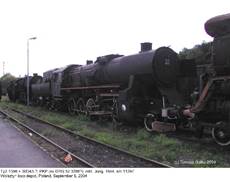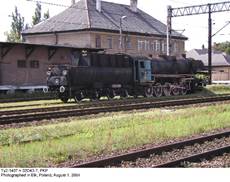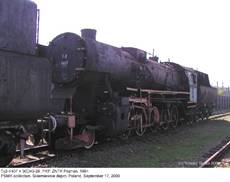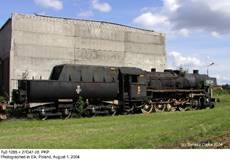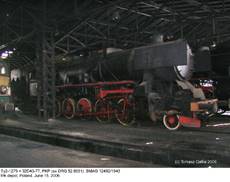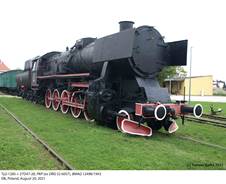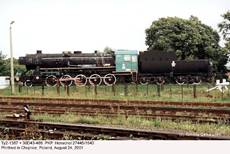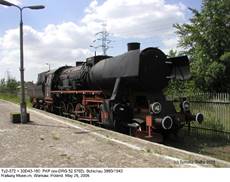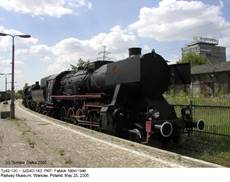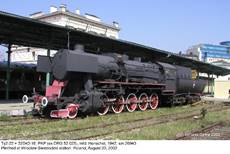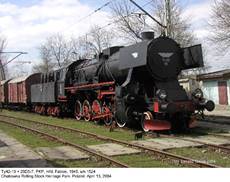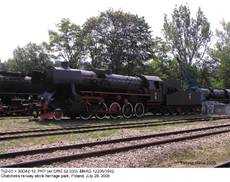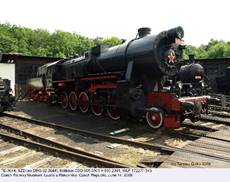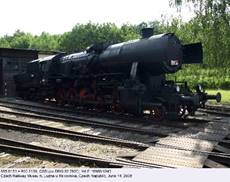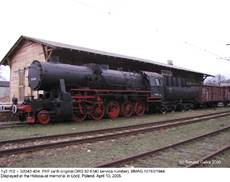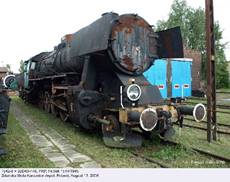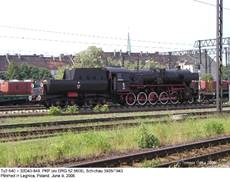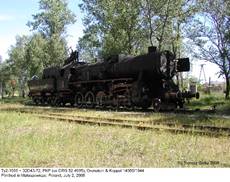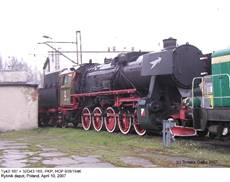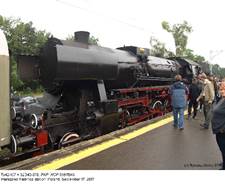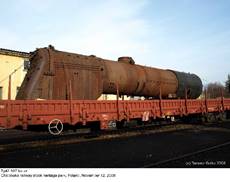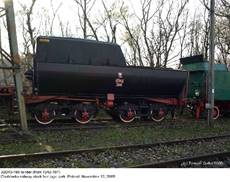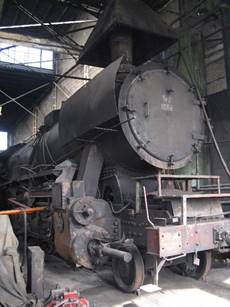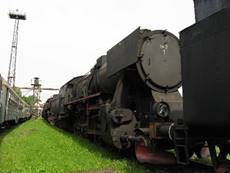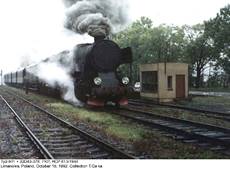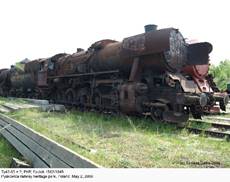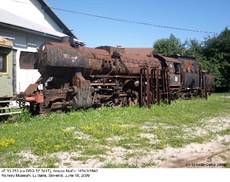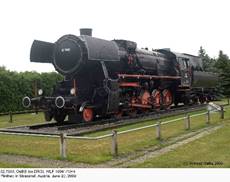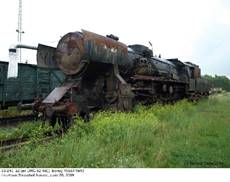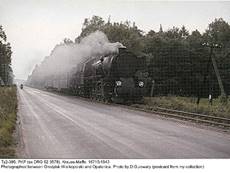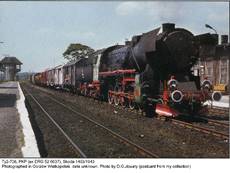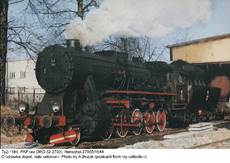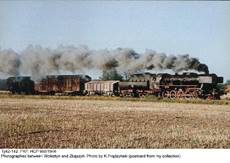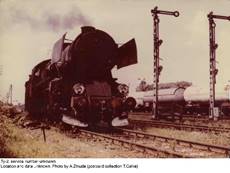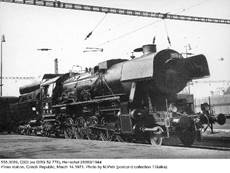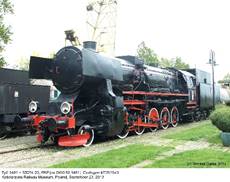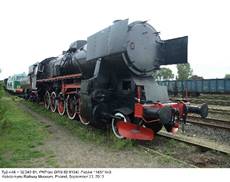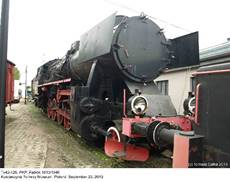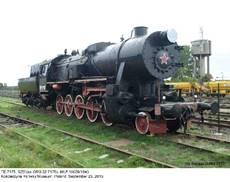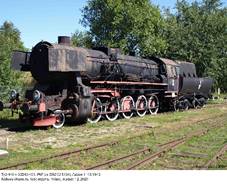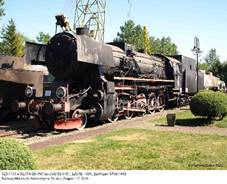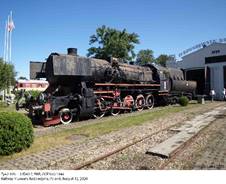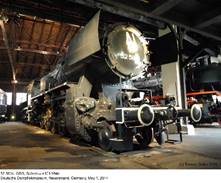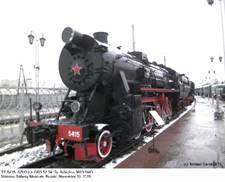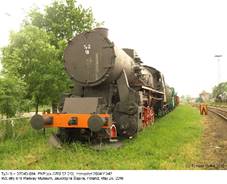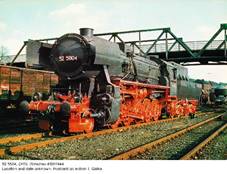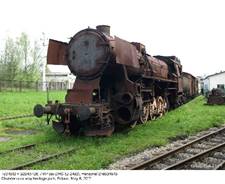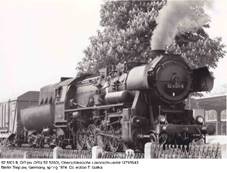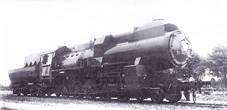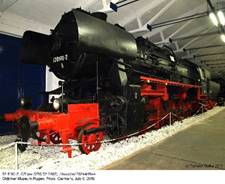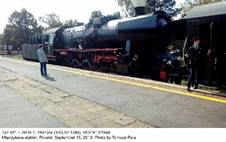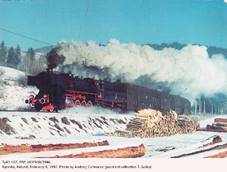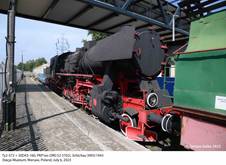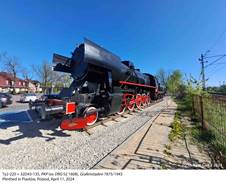Ty2 and Ty42
|
|||||||||||||||||||||||||||||||||||||||||||||||||||||||||||||||||||||||||||||||||||||||||||||||||||||||||||||||||||||||||||||||||||||||||||||||||||||||||||||||||||||||||||||||||||||||||||||||||||||||||||||||||||||||||||||||||||||||||||||||||||||||||
|
Preamble: factory photo of the 52 001
prototype (Borsig
15446/1942). This engine was withdrawn from DB in October 1954. Source: Die
Lokomotive April 1943. Several old photos of Ty2s and Ty42s from my
collection can be found here. To begin with a spirit-raising view: Ty2-953 (Henschel
28163/144) from Chabówka at the Wolsztyn
steam gala; April 29, 2006. In 2006, Ty2-953 was accompanied by the German ‘Reko’ 52 8177-9, ex 52 4996 (MBA
14066/1944). This photo was taken by my wife Anna. 52 8177-9 appeared in Wolsztyn
also in 2005, when Ty2-953 was still not operational. Photo taken on April
30, 2005. Ty2-953 again in Wolsztyn:
April 28, 2007. In 2008, Ty2-911 (HCP
813/1944), also from Chabówka, appeared in Wolsztyn for the first time. Photo taken on May 3, 2008.
It was also accompanied by 52 8177-9; more photos can be seen here. Ty2-911 inside the Chabówka
shed; November 12, 2008. In September 2009, both Ty2-911 and Ty2-953 took
part in the Steam Gala in Chabówka; some pictures
taken on this occasion can be seen here. Ty2-406 (Orenstein & Koppel
13821/1943), photographed in Wolsztyn on April 30,
2005. One more picture from Wolsztyn:
Ty42-148 (Fablok
1647/1946), photographed on April 29, 2006. This lineup can no longer be
seen! Ty2-1169 (Orenstein & Koppel
14372/1944) inside the shed at the Jaworzyna Śląska depot (now Industry and Railway Museum).
Photo taken on August 4, 2004. Another picture of this engine, taken on July 8,
2009. Two more engines from the collection of the Industry and
Railway Museum: Ty2-38 (BMAG
12167/1942)… …and Ty2-305 (Henschel
27688/1943). Both pictures were taken on October 28, 2005. More pictures from
this location can be seen in the wreck section. Jaworzyna
Śląska again: July 8, 2009. Ty2-81 (Henschel
26868/1943) looks much better than a few years later, so it has been moved
here from the wreck section. Ty2-927 (Henschel
27933/1944) on static display at the Pyskowice loco
heritage park; October 9, 2004. Another picture of this engine: May 2, 2009. Ty2-3458 (Krauss-Maffei
16584/1943) from sand railways on static display in Pyskowice,
photographed October 9, 2004…. …and again on May 2, 2009. Three other engines from the sand railways.
Ty2-5680 (Schichau 3958/1943), plinthed in Jaworzno. Photo
taken on October 3, 2003. In May 2011 this engine was transferred to Zabrze
and plinthed at the DB Schenker
Rail Polska premises. Ty2-2118 (Henschel
26874/1943), plinthed at the Kotlarnia
sand mine premises. Photo taken on October 4, 2006. Ty2-7173 (WLF 16626/1943) was sold to
the Nene Valley Railway, Wansford, UK. This
photo was taken on July 23, 2005. Ty2-1298 (Jung 11297/1944),
erroneously designated Ty2-1398, photographed at the Wolsztyn
depot on September 8, 2004. Ty2-1407, assembled at the ZNTK Poznań in 1964, spent a number of years at the Ełk depot; this photo was taken on August 1, 2004 In 2006, Ty2-1407 was transferred to Skierniewice. Photo taken on September 17, 2006. Two more engines from Ełk:
Ty2-1285 (BMAG 12498/1943), August 1, 2004… …and Ty2-1279 (BMAG 12492/1943), June
15, 2006. This picture is poor, but at least it shows the engine to be in a
good condition. Another picture of the Ty2-1285, taken on
August 20, 2021. This Ty2-1387 Henschel
27455/1943) was photographed at the Chojnice depot
on August 24, 2001. Another picture of the Ty2-1387, taken on
June 15, 2025 – almost 24 years later! Ty2-572 (Schichau
3993/1943) is now a part of the Warsaw Railway Museum collection. Photo taken
on May 25, 2005. Railway Museum collection includes also
Ty42-120 (Fablok 1604/1946), which was
photographed on the same occasion. Ty2-22 (Henschel
26943/1942), plinthed at the former Wrocław Świebodzki station.
Photo taken on August 20, 2002. Ty2-16 (Henschel
26844/1942), plinthed at the Stalowa
Wola Rozwadów station, is
probably the oldest Ty2 preserved in Poland. Photo taken on May 4, 2004. Ty42-19 (Fablok
1524/1945), photographed at the Chabówka locomotive
heritage park on April 13, 2004. This engine is coupled with a 26D5 tender. Another engines from Chabówka:
Ty2-29 (Henschel 26971/1942), photographed
on July 29, 2006… …and Ty2-50 (BMAG 12205/1942),
photographed on the same occasion. Another picture of the Ty2-50, taken on
November 12, 2008. Ty2-1184 (Henschel
27965/1944), photographed on the same occasion; missing smoke lifters give
this engine a more wartime appearance. Ty2-14 (Henschel 26974/1942), plinthed in Kartuzy. Photo taken on August 8, 2003. This TE-3644 from SZD (WLF 17227/1943)
has been purchased by a Czech railway fan society and given fictitious service
number 555.0301. Photo taken at the Czech Railway Museum, Lužna
u Rakovnika, on June 14, 2008. TE-3644 bears both Soviet and Czech numbers.
Russian letters above the number indicate Baltic Railroad. Czech Railway Museum collection includes also
555.0153 (ex DRG 52 7620, WLF 16968/1943); photo taken on the
same occasion. Ty2-702 (BMAG 12793/1944),
photographed at the Zduńska Wola
Karsznice depot on May 27, 2001. In 2004, Ty2-702 was plinthed
at the former Łódź Radogoszcz
station to commemorate the Holocaust. The original DRG service number
(52 6340) was restored. Photo taken on April 10, 2005. Another engine from Karsznice:
Ty42-9 (Fablok 1514/1945), photographed on
August 13, 2008. Ty2-540 (Schichau
3935/1943), plinthed at the Legnica depot. Photo
taken on June 9, 2006. This Ty2-1055 (Orenstein & Koppel
14065/1944) has been plinthed in Małaszewicze, near a large transfer station close to the
Belarus border. Photo taken on July 2, 2006. Ty42-107 (HCP 938/1946), Rybnik depot,
April 10, 2007. In April 2013 this engine steamed again. It visited Warsaw
with a special train on October 4, 2015; some pictures taken on that occasion
can be found here. Second visit of the Ty42-107 to Warsaw took
place on September 25, 2016. This picture was taken one day earlier: Jerzy Mikołajczyk managed to capture this engine on the outskirts
of Warsaw (used by permission). More pictures from this visit can be found here. Next visit of the Ty42-107 to Warsaw: Falenica station, September 17, 2017. Chabówka, November 12, 2008: boiler of the Ty42-107… …and 32D43-165 tender shortly after arrival
from Rybnik. Ty2-1086 (Orenstein & Koppel
14327/1944) as a stationary heater at the Leszno
depot. Photo taken on May 30, 2008, by John Bryant – thanks for permission! Another picture from John Bryant: Ty42-1 +
30D43-140 (Fablok 1506/1945), photographed
in Jaworzyna Śląska on
the same day. Ty42-1 again: July 8, 2009. Slightly derelict 52 4752 (MBA
13803/1943), later JŽ 33-107, at the Museo Ferroviario Campo Marzio,
Trieste; October 4, 2008. Ty2-911 again, this time photographed on
October 18, 1992, with a special train in Limanowa… …and in Tymbark.
Both photos by Wojciech Szpigiel
(from my collection). DRG 52
4966 (MBA 14036/1944) at the Deutsche Techniksmuseum,
Berlin; photo taken on May 16, 2009. Ty42-85 (Fablok
1562/1945), photographed at the TOZKiOS
premises in Pyskowice on May 2, 2009. JŽ 33-253, ex DRG 52
3417 (Krauss Maffei 16543/1943),
photographed in the Lublana railway museum on June
18, 2009. ÕBB 52.7593 (WLF 16941/1944) has been plinthed in Strasshof by the
main street; photo taken on June 20, 2009. Two more 52s can be seen at the Heizhaus: 52.7594 (WLF 16942/1944)… …and JŽ
33-240 (ex DRG 52 460, Borsig
15557/1943). Both pictures taken on the same day. Some postcards
from my collection: Ty2-385 (ex 52 3578), Krauss-Maffei
16715/1943 (photo by D. Gulowaty)… ...Ty2-708 (ex 52 6637), Škoda
1463/1943 (photo by D. Gulowaty)… …Ty2-949 (ex 52 2794), Henschel
28358/1944 (photo by H. Magoń)... …Ty2-1184 (ex 52 2733), Henschel
27965/1944 (photo by A. Bożek)... …and
Ty42-142, HCP 958/1946 (photo by K.
Prądzyński). An unknown Ty2, somewhere in Poland. Photo by
A. Żmuda (postcard from my collection). Oil-fired 555.3059, ČSD (ex 52 778), Henschel 28063/1944.
Picture taken on March 14, 1971, at the Plzen station by M. Petr (postcard
from my collection). Ty2-520, former 52 5536 (Schichau
3814/1943). photographed in Osowa on December 29,
1976. Photo by Roman Witkowski (postcard from my
collection). This engine was withdrawn from service in 1980. Several pictures taken at the Kościerzyna Railway Museum on September 23, 2013.
Ty2-1401 (former 52 1481, Esslingen
4705/1943), purchased in the USSR in January 1963 and withdrawn in July 1990… …Ty2-446 (former 52 5134, Fablok 1143/1943), written off
in August 1993… …Ty42-126 (Fablok 1610/1946), which
survived in service until July 2000… …Ty42-105 (HCP 936/1946), written off on the same day… …and somehow exotic Soviet TE-7175 (WLF 16628/1943) in its original
livery. This engine was re-numbered 1042.530-4 by SZD in 1984 and remained in use in Kaliningrad until 1985.
Purchased in the USSR, it was abandoned in Malbork
and later transferred to Kościerzyna. My next visit to Kościerzyna
almost seven years later, on August 12, 2020: Ty2-446… … Ty2-1401… … Ty42-126… … and Ty42-105. 52 5804 (Schichau 4101/1944) on static
display at the Deutsche Dampflokmuseum in Neuenmarkt;
May 1, 2014. Soviet TE-5415 (ex 52 5415, Schichau
3693/1943) at the Moscow Railway Museum; November 19, 2015. Ty2-18 (ex 52 013, Henschel 26941/1942), preserved
at the Industry and Railway Museum
in Jaworzyna Śląska; May
25, 2016. Two pictures from my collection (photos by
Marek Niemiec): Ty2-1279 (ex 52 3567, Krauss-Maffei
16704/1943), photographed during its visit to Warsaw on June 17, 1995… … and Ty2-953 (ex 52 2817, Henschel
28163/1944), working a freight train between Ustrzyki
dolne and Krościenko on
May 5, 1997. Three BR52s photographed at the Lokpark Ampflwang
on August 25, 2016. 52.7102 (WLF
16555/1943) remained with ÖBB after the war and was
withdrawn in October 1978… … 52.3517 (Krauss Maffei 16643/1943) shared a
similar fate and was withdrawn on the same day… … and 52 8134 (WLF 16591/1943) served with DR,
was fitted with the modified boiler in 1965 and remained in use until 1994. TE 6769 (ex 52 6769, WLF 16222/1943), taken over by NKPS after the war, was re-numbered 1042.487-7 in 1984 and since
1993 is on display at the Varshavskiy railway
station in St. Petersburg. Photographed on October 28, 2007 by George Shuklin (www.commons.wikimedia.org).
52 5804 (Schichau 4101/1944) was taken
over by ÖBB in 1945. Withdrawn in March 1975, it was
transferred to Deutsches Dampflokmuseum,
Neuenmarkt-Wirsberg. Location and date are unknown,
but most probably this picture was taken after return to Germany. Postcard
from my collection. Ty2-1312 (ex 52 2482, Henschel 27650/1943) was
transferred from Pyskowice to Chabówka;
picture taken on May 6, 2017. Ty42-107 (operational), photographed on the
same occasion. DR Reko 52 8101 (ex 52 5260, Fablok
1271/1943), Berlin Treptow, spring 1974. This
engine remained in service until April 1985. Photo from my collection. 52 1850 (Henschel 27178/1943) with
‘long’ condensing tender. This locomotive was withdrawn from DB in April 1946 and later used for
testing boiler safety valves. Factory photo, March 1943, source: Deutsche Kriegslokomotiven
(see References). 52 3620 (Krauss-Maffei 16671/1943) with corrugated-furnace boiler.
Withdrawn from DB in November 1952.
Source: as above. 52 4915 (MBA
13985/1943), fitted with Lentz valve gear; factory photo, date unknown. After
the war this locomotive served with DB
and was withdrawn in October 1954. Source: as above. DR 52 8190-2 (Henschel
28244/1944) was originally delivered to DRG
as 52 2887; rebuilt in 1967, it was withdrawn in 1993. Photo taken at the
railway museum in Prora on July 6, 2019. Ty2-911 (ex 52 1346, HCP 813/1944), ‘untypically’ coupled with a 26D5 tender, with a
special train; Warszawa Międzylesie station,
September 15, 2019. Photo by Tomasz Pala (used by permission). Ty42-107 (HCP
938/1946), photographed near Rycerka, Poland, on
February 9, 1997. Photo by Andrzej Cichowicz
(postcard from my collection). ‘Reko’ 52 5732-4, DR (Schichau 4023/1943), fitted
with Giesl-type exhaust nozzle, photographed in
Dresden in June 1971 by Werner Nagel (photo from my collection). This engine
was purchased in the Soviet Union in January 1961 and withdrawn in October
1978. Early production engine: DRG 52 104 (Krauss-Maffei 16415/1943), location and date unknown. Taken
over by PKP and re-numbered Ty2-93,
it was withdrawn in May 1990. Photo by W. Hubert (postcard from my
collection). Back to the Warsaw Railway Museum (now Stacja Muzeum):
Ty2-572 (Schichau
3993/1943)… … and Ty42-120 (Fablok 1604/1946); July 6,
2023. Ty2-220 (ex DRG 52 1608, Grafenstaden 7875/1943) was withdrawn in 1989 and for
several years served as a stationary boiler at the Tłuszcz
depot. It was externally refurbished and plinthed
in Piastów in February 2024. Photo taken on April
11, 2024. |
According
to some sources, the most numerous steam locomotive type ever built is
Russian/Soviet class E (Э in Russian script), which remained in
production until 1950s. This class should, however, be regarded not a
distinct type, but rather a family of types that only shared the common
layout and some basic design features. Some of them differed from the others
almost as much as a Toyota Corolla of 1965 from a Toyota Corolla of 2005. The
aforementioned distinction will thus most probably go to DRG class 52. Demand
for higher tractive effort while maintaining axle load at an acceptable level
logically leads to an increase of the number of coupled axles. This obvious
tendency is well exemplified by the development of Prussian heavy freighters:
classes G7, G8 and G9, which featured either 0-4-0 or 1-4-0 axle
arrangements, were followed by class G10 with five coupled axles (0-5-0). In
order to improve running qualities at higher speeds, which was becoming
important even with freight trains, lead truck was added and thus the 1-5-0
axle arrangement was introduced. Locomotives with six coupled axles were few,
and only one engine with seven coupled axles was ever built (Soviet type AA,
which proved unsuccessful and remained a single prototype). Thus, until the
end of steam era, Decapod held the position of the most important type
of heavy freighter in Europe. And the most numerous Decapods were DRG
52s that served throughout the continent. In
fact, the first 1-5-0 in the KPEV (Königlich Preußische Eisenbahnverwaltung)
service appeared in 1917; class G12 was a very successful three-cylinder
locomotive with the tractive effort of 18.2 tonnes.
It was followed in 1926 – when all
railways of German lands had already merged into DRG – by BR44,
heavier by about 14 tonnes and with tractive effort
increased to 19.5 tonnes. Even heavier BR45
featured rear idle axle (1-5-1); prototype appeared in 1936, but only 28
examples were eventually built. In the meantime, advantages of the Decapod
layout were being exploited also in lighter machines. Two-cylinder BR50
weighted less than G12 by almost nine tonnes, but
axle load was reduced from 16.7 to 15.2 tonnes,
which made the engine much more versatile. This successful locomotive was
intended to replace elderly Prussian G10s (DRG class 5710-35),
as well as numerous obsolete freighters of former Austrian and Czech
railways, incorporated into DRG in late 1930s. Prototype appeared in
early 1939 and, as the war broke out, pretty soon it turned out that this
type was well suited to service in vast occupied territories in Eastern
Europe. As a result, it was one of the three Einheits
types (the other two were BR44 and BR86) selected to remain in production
after strict rationalization measures had been adopted; total output exceeded
3100 examples. After the war, over fifty served with PKP as class Ty5. Until
1941 it became obvious that reduction of production program to just three
above-mentioned types would not suffice. Further dramatic simplifications
were necessary to boost output and conserve strategic materials. Thus, in
March 1942, BR50 ÜK (Übergangs-Kriegslok, or
interim war locomotive – sometimes given as Übergangs-Kriegsausführung,
or interim war version), made its appearance, to remain in production until
late 1943 (a few more examples were built by Belgian factories in 1944). In
parallel, a new design was being developed, based on well-proven BR50 and
designated BR52, but also referred to as KDL-1: this abbreviation stood for Kriegsdampflokomotive, or wartime steam
locomotive. All conceivable means to accelerate production and conserve raw
materials were taken. Many items of equipment were simply deleted: second
sand dome, feedwater heater, smoke lifters,
connecting rods bushing adjustment and even steam bell. Wide introduction of
forgings and crude machining (or no machining at all) brought about further
savings: for example, connecting rods were welded from three drop-forged
pieces and cutouts in side sills were simply cut with a torch. Plate frame
was introduced, instead of more rigid bar-type one; it was argued that
expected short service life (estimated at about five years) justified such
measure. In effect, both frame types were employed by individual
manufacturers. BR 50 and BR 52 boilers were basically interchangeable, but in
the latter engine St34 steel was used instead of St47K, which had turned out
to be prone to premature ageing (this was one of the major problems of some
German pre-war Einheitslokomotiven). Drawing
on experience from the first winter at the Eastern front, many parts, including
cylinders and air compressors, were exceptionally well insulated. In order to
improve working conditions during winter, cab was made fully enclosed. While
an early (pre-war) production BR50 needed about 20,000 man-hours to complete,
in BR52 this figure fell to about 6,000. Consumption of raw materials,
particularly brass, copper, tin and aluminum, was greatly reduced: for
example, as compared to BR50, new locomotive needed 127 kg of copper instead
of 2358 kg – of course, mainly due to steel firebox. Virtually every element
(even the steam whistle) was carefully examined from the point of view of
conserving non-ferrous metals which were in short supply. A price had to be
paid, however: economy suffered considerably and running qualities –
especially tender-first – left much to be desired. Typically
BR52s were coupled with 2’2’T32 four-axle tub tenders of welded construction.
Manufacture of these tenders, light and fast to build, was scattered among
fifteen companies from outside the locomotive industry. K4T30 tenders with
all four axles in a rigid frame, developed by WLF, were also widely
used, while some engines delivered to various satellite states during WWII
had 2’2’T26 tenders. 137 examples (52 1850 through 52 1986) were fitted with
five-axle 3’2’T16KON condensing tenders, but overall length of over 27.5 metres made them somehow unwieldy – they could not match
existing turntables – so further 41 engines (52 1987 through 52 2027) were
coupled with shorter 2’2’T13,5KON condensing tenders. The need for condensing
BR52s resulted from the conquer of vast areas in the East, where water supply
was erratic; however, they appeared in number after these territories had
already been abandoned. Prototype
52 001 was built by Borsig (s/n 15446/1942) and
rolled out on September 15, 1942 (some sources give September 12). Initial
plans, so-called Führerprogramm, envisaged
15,000 BR52s in two years, but soon they were cut down to 7,000 examples and
then again increased to 10,000. Production was intended to last until June
1944, in order to give way to BR42, which was considered more useful in the
East. Orders were placed with most of German locomotive manufacturers: Borsig, Esslingen, Henschel,
Jung, Krauss-Maffei, Orenstein
& Koppel (MBA), Schichau and BMAG
(former Schwartzkopff). In fact, only two
major ones were excluded: Krupp Lokomotivwerke
of Essen, destroyed by an Allied air raid, and Hannoversche Maschinenbau AG
(Hanomag),
which had to concentrate on armament production. Furthermore, several manufacturers
in the occupied Europe joined the program: WLF (Floridsdorf)
in Austria, SACM (former Grafenstaden)
in France, Škoda in Czechoslovakia, as well
as Deutsche Waffen- und Munitionsfabriken
AG Werk Posen (former HCP) and Erste Lokomotivfabrik
Oberschlesien Krenau (former
Fablok) in Poland. Four Belgian factories
commenced BR52 production only after the war. Other numerous companies
supplied tenders, boilers and various items of equipment. Despite initial
plans, production lasted until the end of WWII – in fact it continued into
the 1950s. Not all orders originally intended were
actually placed and overall output fell much short of the envisaged figure –
but total production figures are nevertheless outstanding. Exact numbers
given by various sources differ considerably, due to at least three factors:
some machines were delivered after the war or not completed at all; some
BR50s (Kurt H. Miska gives 323 or 328) were
completed as BR52s; and some were destroyed in air raids prior to delivery or
formal acceptance by DRG. It seems that historians and even keenest
statistics addicts (of whom I am probably one) have not reached any consensus
on that subject. Most of them quote figures in the range from 6,400 to 6,700,
excluding those built after WWII in Belgium and Poland. EZ quotes
6,728 only to state immediately that such exact figures may be correct or
not. The highest service number is 52 7794 (MBA 14378/1944). There
were gaps in numbering: individual manufacturers were assigned blocks of
numbers, but not all engines were completed, accepted by DRG or even
ordered. Sometimes entire blocks were re-assigned; this explains why, for
example, the first BR52 from Fablok had
higher service number than the last one. The monograph by Ryszard
Stankiewicz and Roman Garbacik
(see References), published in 2013, gives 6567 examples, excluding post-war
production in Poland and engines assembled in the USSR from parts obtained
from wrecks. It has to be mentioned that a
0-5-0 variant of the BR52 was also proposed. Design was entrusted to WLF,
but the idea was finally abandoned and the project remained on the drawing
board. There were also several modifications of the basic design. Five
examples (52 3620 through 3624 from Krauss-Maffei) were ordered with corrugated-furnace boilers
(Wellrohrkessel),
but only first four were completed. 52 4915 (MBA 13985/1943) was fitted with Lentz-type valve gear. All these
locomotives were built in 1943; further experiments were discontinued, as
output was given priority. After
the war, BR52s shared the fate of other German locomotives: some remained in
Western and Eastern zones, while the majority went to various countries. Of
over 900 examples that were in Western occupation zones in 1945 (many of them
unserviceable), some were exchanged with other railway managements or
withdrawn to reserve. On the other hand, a few dozen (according to my data,
86) engines ordered by DRG were completed after the war by Jung
and Henschel and finally delivered to DB.
Some of them were later used to test new design features, like Franco-Crosti boilers; 52 138 (Henschel 28291/1949) was fitted
with feedwater heater and turbine-driven feedwater pump. According to some sources, DB had
701 BR52s in all, but obviously a large part of them saw little or no
service. In 1958, DB had just 38 examples (including 26 from post-war
production) and last of them was withdrawn in May 1963. According to Kurt H.Miska, as many as 1364 BR52s were in the Eastern zone
when the war ended, but many were taken by the Soviets or transferred to
other railway managements (including PKP). DR finally ended up
with 684 engines, which made up undoubtedly their most important post-war
class. This number includes sixty examples purchased in the Soviet Union in
1961. 200 engines of this type were rebuilt and fitted with new boilers of
modified design; all were given new service numbers, 52 8001 through 8200.
Between 1953 and 1958 further 25 were converted to pulverized coal firing;
these retained their initial service numbers, but first digit was replaced by
‘9’ (in cases of three-digit numbers, ‘9’ was simply added). This conversion
was intended to facilitate lignite firing: Eastern Germany had considerable
resources of lignite, while hard coal of suitable quality was scarce.
However, due to dust accumulation and frequent flashbacks from the firebox,
this conversion was not entirely
successful; last converted engines were withdrawn in 1979. ‘Reko’ 52s remained in the DR service until
mid-1980s and many have been preserved. Several
BR52s finally found rather exotic destinations (at least for a European
engine), like Japan, Vietnam or USA. List of post-war users includes, apart
from Germany, seventeen countries. Brief summary, based on available sources,
is given in the following. Most data had been taken from Kurt H.Miska’s website http://www-personals.umich.edu/~khmiska,
which was an excellent reference on several wartime German locos
(unfortunately, this site is currently dead); some have been compared with
that from other sources. -
Austria: post-war state railways ÖBB received
345 engines, which retained their original service numbers. Many were written
off in late 1940s. Class designation was 52 (plate frame) or 152 (bar frame);
ÖBB were the only railway
management to distinguish these two variants. Instead of space there
was a dot between class number and service number, in the Austrian manner.
Last were withdrawn from service in 1976, as the last steam engines with ÖBB.
Further 404 examples that remained in the Soviet occupation zone were later
impressed into the MPS service. -
Belgium: three BR52s with condensing tenders, left
by Germans, were impressed into the SNCB service and re-numbered 2800
through 2802; they were returned to DB in 1950. Between 1945 and 1946,
four Belgian factories (Cockerill, La Croyere,
Haine St.Pierre
and Tubize) delivered 99 brand-new engines
for SNCB, designated class 26. These locomotives were a part of a
batch of 150 examples ordered by DRG, of which not a single one was completed
before German withdrawal. They remained in service until 1964. -
Bulgaria: as a German ally, Bulgaria received a
number of BR52s leased from DRG, the first one arriving in May 1943. Their
highest number in service was 133 (June 1944). Of these, 85 were impressed
into state railways BDŽ as class 15; formally they were considered
Soviet war booty and were purchased by BDŽ in December 1946. These
engines obviously enjoyed a good reputation and much more second-hand
examples were obtained later. Twenty were bought from DR in May 1956,
twenty from ČSD in late 1958 and ten again from DR in June 1959
(initially leased for one year, then purchased). As many as 140 were bought
in the Soviet Union between January 1961 and May 1964. This makes a grand
total of 275 examples. They were used with both freight and passenger trains
and gradually withdrawn to reserve in 1974 and 1975; last were written off in
1980. -
Czechoslovakia: renowned Škoda
company contributed to the BR52 program by building 153 engines. After the
war, many BR52s were based in Czech and Slovak depots (possibly over 600),
but most were taken by the Soviets and only 185 were impressed into the ČSD
service as class 555.0 (service numbers, after various rearrangements,
555.001 through 0185). Nine of them were later converted for the 1524 mm
gauge and re-numbered 555.0601 through 0609 (after a few years they were
re-gauged again). In early 1960s additional 100 examples were purchased in the
USSR and impressed into service as 555.0201 through 0300; all were later
converted to oil firing (as well as 99 examples from the first batch), which
was indicated by replacing the first ‘0’ digit in the service number by ‘3’.
Additional twelve second-hand BR52s were purchased for various industrial
establishments. One more Czechoslovakian engine deserves mentioning: 52 1965
(Henschel 27293/1943, with a
condensing tender) was armored and briefly used as 559.0701: judging from
photos, it did look impressive! In 1955 the armor was removed and the engine
served until December 1968 as 555.0177, with a standard tub tender. Last
locomotive of this type, 555.0259, was written off in May 1973. -
France: in all, SNCF took over 25 engines of
this type as class 150Y. This number includes seventeen examples ordered by DRG
from SACM (Grafenstaden) as 52 1739
through 1755, but completed in 1946 (factory numbers 8006 through 8022).
Initially they all retained their DRG service numbers, but in 1948
those completed after the war were re-numbered 150Y-1 through 150Y-17. All
were based in north-eastern France and last survived in service until March
1959. -
Hungary: first BR52s for state railways MÁV
from DRG came in September 1944 and their number eventually reached
71, to fall to 61 until the end of hostilities. After the war, Soviet
administration of MÁV supplemented this modest fleet with 66 engines
from Czechoslovakia and eight from Austria. When the occupation ended, these
engines were returned to (or rather taken by) the Soviets. Due to shortage of
locomotives, MÁV bought twenty surplus BR52s from ÖBB in 1957;
100 more from the Soviet Union followed in 1963, plus six more broad-gauge
ones for cross-border traffic. All were classed 520. They withdrawal started
in early 1970s and was completed until 1979. -
Italy: state railways FS never purchased
BR52s, but a number of these engines were used by the German army. After the
war, 54 of them were impressed into service with FS; ten more from
Austria followed until 1947 when all Italian engines of this type were
returned to DB. -
Japan: in 1977, withdrawn ÖBB 52.2436 (Henschel 27604/1943) was sent to Japan and
displayed as a tourist attraction at Hotel Biwasee
in Kioto. By the way: Japanese railway gauge is
1067 mm! -
Luxembourg: in mid-1946 CFL rented ten
Belgian 26s, which were impressed into service as class 56. Ten more were
purchased from French SACM (Grafenstaden);
these machines were initially ordered by DRG (as 52 1756 through 1765,
factory numbers 8044 through 8053), but completed only in 1946. Class 56
remained in service until 1955. -
Norway: between 1944 and 1945 state railways NSB
received 74 BR52s, classed 63a; DRG service numbers were retained.
They served until 1970. Four survived in an abandoned tunnel until 1972; one
was restored as a heritage locomotive and one was sold to Bressingham
Steam Museum and Gardens, Diss, Norfolk, UK. -
Romania: state railways CFR obtained 100
brand-new BR52s (no prior DRG numbers assigned) in 1943; they were
classed 150.1000 and given service numbers 150.1001 through 1100. In January
1944 further 160 were leased from DRG. Most of them were taken back to
Germany, as well as to Hungary and Austria; over sixty fell into Soviet
hands. Post-war engine numbering included 150.1101 through 1123, which many sources
claim to be ex-DRG BR52s; it is, however, known that the 150.1114,
preserved in Brasov, is in far ex-DRG 50 517. Many Romanian engines of
this class, possibly all, were converted to oil firing. They survived in
service until late 1980s and about ten reportedly still exist. -
Soviet Union: MPS (Soviet ministry of
transport) acquired a large number of BR52s, probably over 2100. First were
captured in 1943, but the majority arrived between 1945 and 1948, when Soviet
authorities were scouring occupied territories in search of locomotives that
could supplement the MPS fleet; it should be kept in mind that Soviet
locomotive factories during the war built mainly tanks. BR 52s were initially
used with original German designations. Later they were re-classed TE
(TЭ in Russian script), where T stood for ‘trofyeinyi’,
or booty, and E indicated the indigenous type with similar tractive
characteristics; DRG numbers were retained. Additional 36 examples
were assembled from various parts, mainly recovered from wrecks, by railway
stock repair works of Ivano-Frankovsk in western Ukraine (pre-war Polish Stanisławów) and assigned numbers TE 8001 through 8036.
Three more, TE 9001 through 9003, were assembled by another works, probably
in Lugansk. Many, perhaps even all, re-gauged Soviet BR52s had their boilers
rebuilt and fitted with circulation tubes, which increased evaporating
surface from 177.6 to 192.5 sq.m; they could be
distinguished by small, circular smoke-box door, offset downwards. Soviet
railways found this type very useful, but comparatively small grate area was
a problem with low-grade coals usually available. Together with some other
major types, a large number of TEs (some still in the 1435 mm gauge version)
were kept as a part of the military reserve close to the Western border,
mainly in the Kaliningrad district, Lithuania and Belarus. These engines, all
facing west (or so the story goes), were basically kept in working order and
fired from time to time; some of them reportedly still exist. From 1956
onwards a large number of TEs went to industry and over 700 were sold to the
satellite countries, including Poland. Over 600 survived in the SŽD
inventory until mid-1980s, when they were re-designated class 1042 and given
new consecutive service numbers. A few survived until 1990s. -
Turkey: despite remaining a neutral country
throughout the war, Turkey obtained a number of German (as well as British
and American) locomotives. In 1943, Turkish state railways TCDD
received ten brand-new BR52s from Henschel
(factory numbers 27735 through 27744), which became 56501 through 56510 (TCDD
had no distinct class designations). Further 43 examples arrived in late 1943
and early 1944, but these were DRG engines (albeit almost new),
initially loaned and formally purchased only after the war. Due to
comparatively low axle load, BR52s were found very well suited to local
conditions and remained in service until late 1980s, with both freight and
passenger trains. Some were converted to oil firing. -
USA: in July 1945, 52 3674 (Fablok
1287/1943) and 52 2006 (Henschel
27334/1944), the latter with a condensing tender, were shipped to the USA for
evaluation. After extensive tests at Fort Eustis and Fort Monroe, VA, both
were scrapped in 1952. It is worth mentioning that first American review of
this engine, based on intelligence reports, was published in May 1943: BR52
was described as ‘a light model of moderate power, suitable for operating
branch lines and local services, but not suitable for heavy, main-line
post-war traffic in the Reich’ (Tactical and Technical Trends, No.24,
May 6, 1943). -
Vietnam: a number of Polish and Soviet engines of
this type (various sources give 12 to 16) were sent as a gift to Northern
Vietnam. Little is known of their subsequent fate, apart from the fact that due
to very poor track quality these otherwise undemanding locomotives saw little
service. -
Yugoslavia: during the war, both Serbia and Croatia,
with their puppet governments, were German allies and were supplied with 15
and 24 brand-new BR52s, respectively (Serbian SDŽ class 33 and
Croatian HDŽ class 30); most probably 25th Croatian engine
was not built at all. These engines had no DRG numbers. After the war,
33 of them were impressed into the JDŽ service as class 33, retaining
their original numbers. Further 188 were obtained as a part of war
reparations. 35 were purchased from DB in 1952 and 76 in the USSR
between 1964 and 1966. According to C.J.Halliwell’s
The Locomotives of Yugoslavia (many thanks to Toma
Bacic!), post-war JDŽ (later JŽ)
class 33 numbered in all 337 examples (some sources give 303 or even 240),
plus five more for mining railways, designated 33-501 through 505. They
remained in service until mid-1980s and, according to some sources, a few
were occasionally used during the civil war in the 1990s. To add some
complication, 33-178 and 33-179 were BR50s. Post-war
modernizations were numerous and aimed mainly at eliminating wartime
austerity measures. Even brief description is beyond the scope of this entry.
Most BR52s after the war were fitted with long, narrow Witte-type smoke
lifters, which in the DRG service were usually missing. Some had feedwater heaters added. Excessive insulation,
unnecessary in many countries and inconvenient from the point of view of
maintenance, was often deleted. Condensing tenders, unnecessary in Europe and
difficult to maintain, were replaced by typical tub tenders or whatever was
at hand. Poland
was a major recipient of these engines, second only to the Soviet Union.
Comparatively many examples were left in the Polish territory during the
closing stages of the conflict; this resulted from the fact that, during
evacuation westwards, more valuable engines, like BR44s and BR50s, were
usually given priority. Many BR52s captured by Soviet troops were immediately
impressed into service, often with German crews. Generally those previously
assigned to depots in the Polish territory were passed over to PKP,
but this rule was not strictly observed. Many engines initially taken over by
PKP were finally taken by Soviet military railway authorities and
never returned; on the other hand, Polish railways received a number of BR52s
initially transferred to DR or ČSD, as well as a few examples
returned by the Soviets. After final adjustments, in late 1940s PKP
were left with 1206 engines, classed Ty2 and given consecutive service
numbers from Ty2-1 onwards. Ty2 quickly became the most numerous and most
important class in the PKP service and hauled virtually all types of
trains, even express ones. Many wartime simplifications were rectified during
overhauls. In particular, standard safety valves were fitted instead of
cast-iron plates on cylinders that often broke for no reason; motion gear
elements were modified; a plate protecting front axle was fitted; Trofimov-type piston valves were introduced; and
Witte-type smoke lifters were standardized (a few Ty2s were fitted with
smokebox-mounted smoke lifters from Ol49 or OKz32). Due to material fatigue,
which became a serious problem in mid-1950s, many engines underwent firebox
strengthening. Later, a modified firebox with circulation tubes and
articulated stay bolts was standardized and rocking grate was fitted. In 1960
there were still 1182 Ty2s in service, scattered throughout the country,
which indicates that this class was by no means considered an interim measure
before better engines became available. BR52s
were also built in Poland after the war. As mentioned above, both HCP
and Fablok, under new names and German
supervision, were included in the BR52 program. HCP, after delivering
70 BR50s and 72 BR86s, shifted to BR52. First Kriegslok,
52 1100 (s/n 514/1943), was rolled out in May 1943 and the last one, 52 4563
(s/n 879/1945), was accepted by DRG on January 14, 1945, eight days
before German troops were forced out of Poznań.
Total output was 367 examples. Fablok, apart
from a number of various standard-gauge and narrow-gauge locomotives for
German army and industry, built 140 BR44s and later also shifted to BR52.
First Kriegslok, 52 5125 (s/n 1134/1943),
was completed there in April 1943; production lasted until December 1944 and
totaled 372 examples, the last one formally accepted by DRG being 52
4373 (s/n 1505/1944). Production, in both Poznań
and Chrzanów, was re-commenced immediately after
liberation and, formally speaking, consisted in completing wartime DRG
orders, taken over by PKP – if there was any time for formalities. As
there were certainly problems more urgent than new designation system (which
was introduced only in June 1945), first engines were completed and accepted
with DRG numbers as 52 4374 through 4380 (from Fablok)
and 52 4564 through 4574 (from HCP). Then they were classed Ty42 and
given service numbers from Ty42-1 onwards. Production lasted until July 1946
both at Fablok (Ty42-1 through -28, -82
through –101, -117 through -131 and -147 through -150 – 67 examples) and HCP
(Ty42-29 through –81, -102 through -116 and -132 through -146 – 83 examples),
totaling 150 engines. They were phased out at both factories in favor of
heavier Ty45, developed from pre-war Ty37. First Ty42s from HCP,
completed in early 1945s (seven or eight), were immediately taken by Soviet
military railways. Six of them were never returned; according to available
sources, four ended up with SŽD, one was sold to Bulgaria in 1964 and
one was transferred to DR and designated 52 1505 (second with this
number – it was initially ordered as 52 4571, although Ingo Hütter gives that it was impressed into the MPS service
as TE-4505). These six engines have been assigned their PKP numbers
only formally and never carried them. Ty42 was basically identical with BR52
and underwent the same modifications. Initially almost all Ty42s were
assigned to the Katowice regional management; later – together with Ty2s –
were scattered throughout the country. During the production run, several
modifications – sometimes forced by lack of certain items – were introduced.
When stocks of electric turbo-generators, headlights and even bulbs ran out,
a number of Ty42s were delivered with kerosene headlights. The same was with
speed meters, which were omitted in a number of engines. There were also
problems with tenders, as few tub tenders were initially available for
manufacturers. Production of simplified 2’2’T30 tenders (in the PKP
service, 30D43) was undertaken at HCP only in January 1946. Intensive
electrification, started in the 1950s, envisaged rapid withdrawal of
‘obsolete’ steam locomotives. These plans soon proved sadly over-optimistic,
but production of steam engines for PKP was terminated in 1957 and
many older steamers were written off and scrapped. In early 1960s an acute
shortage of locomotives was thus experienced and, as an emergency measure,
220 TEs were purchased in the Soviet Union. Twenty went directly to sand
railways; they retained their original service numbers, but with the Ty2
class designation (due to this fact, there were two Ty2-52s). 200 examples
for PKP became Ty2-1207 through 1406, all being delivered between 1962
and 1964. According to many statements, Soviet engines, although taken from
the military reserve, were poorly maintained and often in bad overall
condition. I cannot recall a photo of a Ty2 with the MPS-type small,
offset smoke-box door, so most probably the majority had not been modernized
or converted to the 1524 mm track. The last example, Ty2-1407, was accepted
in 1964. This engine is, in a way, mysterious: it was assembled at the Railway
Stock Repair Works (ZNTK) of Poznań from
various spares, but it is not clear if any ‘original’ BR52 served as a basis
– and, if so, which one. Some older sources give that this was 52 3388 (Krauss-Maffei 16514/1943), which is not correct. According
to rosters given in SK 4/99, on October 1, 1965, PKP had 1384
Ty2s, which composed 24% of all steam engines in the company’s fleet. Five years
later this number had fallen to 1371 (28%), and ten years later to 1285
(33%). Corresponding numbers for Ty42s are 144, 143 and 139. A number of
Ty2s, withdrawn from PKP, went to various industrial establishments;
in particular, ten were transferred to sand railways, where they joined those
twenty already mentioned (but retained their PKP service numbers).
Three (Ty2-464, Ty2-1214 and Ty2-1220) were presented to Vietnam in 1985. As
electrification progressed and large numbers of diesel locomotives from
Romania (class ST43) and Soviet Union (class ST44) were accepted, Ty2s and
Ty42s were gradually relegated to local lines, for which they were well
suited, due to low axle load. There they soldiered on with freight and
passenger trains almost until the end of the 20th century. Much to
the joy and satisfaction of numerous railway fans from all over Europe: in
early 1990s, when security measures, strictly observed during the Communist
times, had already been lessened, it was comparatively easy to spot a Ty2 or
Ty42 with a few coaches or a motley collection of freight cars and take
pictures. Frank Engel’s website (www.frank-engel.de)
provides a number of fine examples. But nothing will last forever: the last
Ty2-406, based at the Wolsztyn depot, was withdrawn
from regular service in 2000. In
1984 and 1986, Ty2-1285 and Ty2-953 were fitted with producer gas combustion
systems by the repair works of Piła, in
co-operation with Warsaw University of Technology. This experiment was
successful and overall performance improved considerably, but it simply came
too late and no further conversions were made. Both these engines were later
re-converted to standard variant and both still exist. Similar experiments
were also performed by other railway managements, but withdrawal of steam
engines finally rendered them unnecessary. At
present (late 2014), 54 Ty2s and 14 Ty42s still exist in Poland, but some of
them are merely wrecks. In fact during early 2000s a number of Ty2s and Ty42s
were scrapped, for example Ty2-67, Ty2-642 and Ty42-87 from Wolsztyn (April – May 2003) and Ty2-6 from Zbąszynek (February 2004). All were in very poor
condition. The fleet of survivors includes the mysterious Ty2-1407, Ty42-1
(the first Ty42 from Fablok) and one engine
that never served with PKP or sand railways: ex-Soviet TE-7175 (ex DRG
52 7175, WLF 16628/1943). The latter was purchased in the Soviet Union
by an unknown German company (or a private person), but abandoned in Malbork and later transferred to the Kościerzyna
locomotive heritage park, where it can be seen on static display in original
Soviet livery. Two Ty2s are in working order: Ty2-911 (HCP 813/1944)
and Ty2-953 (Henschel 28163/1944); both are
based in Chabówka and can sometimes be seen with
special trains. The year 2013 saw two Ty42s brought back to the working
order. Chabówka-based Ty42-107 (HCP 938/1946)
steamed again in April and Ty42-24 (Fablok
1529/1945) from Pyskowice followed in June. Both
occasionally run with special trains. Five
Ty2s (including four from sand railways) were sold in early 1990s to: -
France (Ty2-993, Jung 11331/1944, Galerie Les Frigos,
Paris, static display, and Ty2-6690, WLF 16121/1943, Chemin de Fer de la Vallée de l'Aa, Arques, operational); -
Belgium (Ty2-3554, Krauss-Maffei
16691/1943, Patrimoine Ferroviaire Touristique,
Saint-Ghislain, designated SNCB 26.101,
operational); -
Germany (Ty2-454, HCP 860/1944, Hessencourier, Kassel, designated 52 4544,
operational); -
UK (Ty2-7173, WLF 16626/1943, Nene Valley
Railway, Wansford, static display). Moreover,
three Ty42s, taken by the Soviets in 1945, still exist outside Poland.
Ty42-29, now TE-4564 (HCP 880/1945) is on display at the railway
museum in Kaliningrad. Ty42-30, now TE-4565, is still kept at Berestovica, Belarus; according to Russian sources, it
had not been converted to the 1524 mm track and was refurbished (externally?)
in December 2004. Ty42-32, now TE-4567 (HCP 882/1945) is plinthed in Radzivilishki,
Lithuania. A few hundred Kriegsloks still
exist elsewhere. BR52
is one of my favorite steam engines. Once I intended to write a monograph on
this type, but before I could spare enough time, Ryszard
Stankiewicz and Roman Garbacik
published its monograph – see References. I suppose that it is appropriate to
end this entry with a quotation from ‘Doctor’s’ website (www.parowozy.net), which corresponds to
this monograph’s title: ‘Perhaps they should be remembered as mostly peaceful
engines, not war-time ones?’. Main technical data – Ty2
1)
Depending on variant. 2)
Including 20 purchased for sand railways. 3)
Post-war production continued until 1950. 4)
Estimate – see main text. Main technical data – Ty42
1)
Or 143 – data are uncertain. 2)
With the 30D43 tender 3)
Some sources give 145 000 kg. References
and acknowledgments
- Kurt H.Miska (http://www-personal.umich.edu/~khmiska, also private communication – unfortunately this link is no longer active); - Toma Bacic (private communication); -
Michał ‘Doctor’ Pawełczyk (www.parowozy.best.net.pl); -
TB vol. 1, EZ, PNPP; -
SK, various
issues; - monographic article on Ty42 by Tomasz Roszak (SK vol. 4/2003); - Ty2 – wojenna lokomotywa na pokojowe czasy (Ty2 – Wartime Locomotive for the Time of Peace) by Ryszard Stankiewicz and Roman Garbacik (Eurosprinter, 2013); - Deutsche Kriegslokomotiven by Alfred B. Gottwaldt (Transpress, 2016). |
||||||||||||||||||||||||||||||||||||||||||||||||||||||||||||||||||||||||||||||||||||||||||||||||||||||||||||||||||||||||||||||||||||||||||||||||||||||||||||||||||||||||||||||||||||||||||||||||||||||||||||||||||||||||||||||||||||||||||||||||||||||||












